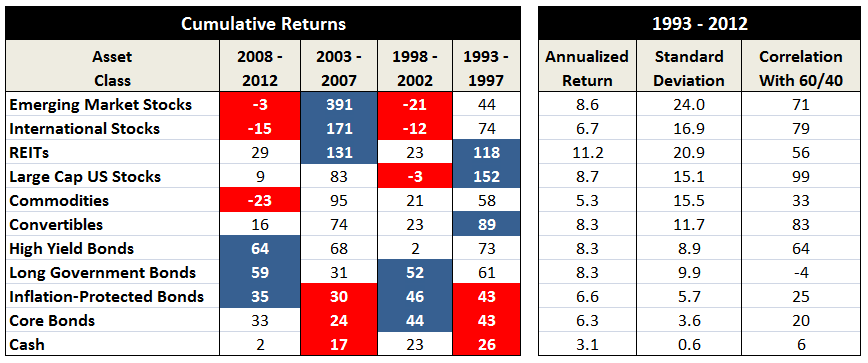Questioning Rob Arnott s Fundamental Index As An Investment Vehicle (ETF PRF) PowerShares FTSE
Post on: 8 Май, 2015 No Comment

Rob Arnott is a very smart man. He edits the Financial Analysts Journal, and manages the PIMCO All Asset Fund (MUTF:PASAX ), which seeks to earn high real returns by tactically shifting between most of the asset classes that The Index Investor and Retired Investor use in our model portfolios (e.g. real return bonds, foreign bonds, commercial property and commodities). In many ways, Arnott’s fund is as close as a retail investor can come to a global macro-style hedge fund.
But recently Arnott has become best known for the turmoil he created in the indexing industry with the publication of his paper on Fundamental Indexation (co-authored by Jason Hsu and Phillip Moore). In essence, Arnott found that a portfolio of companies weighted by various measures of size (e.g. revenues, cash flows, book asset value) outperformed (in the past, at least) a portfolio weighted by companies’ equity market capitalization. Arnott’s findings imply that, in aggregate, investors have been systematically undervaluing large companies (based on sales, assets, and/or cash flow) relative to small companies.
However, if one believes that financial markets are generally efficient, this shouldn’t happen, as market capitalization based weighting should provide the best estimate of future returns. So what is going on?
In our search for potential explanations for the phenomenon (or “anomaly) identified by Arnott, we’ll start with the basic valuation equation. The market price of a company’s stock is a function of (a) the current dividend (or, if you prefer, cash flows to equity holders), (b) the rate at which these cash flows are expected to grow in the future; (c) expected future risk free interest rates; and (d) expected future equity risk premiums (for the overall market and for the company relative to the market). Since the current dividend and risk free rate are known, the most likely sources of valuation errors are estimates the future growth rate of a company’s cash flow, and/or estimates of the relative riskiness of those cash flows.
This leads to four (not mutually exclusive) possible sources of the systematic valuation error captured by Arnott’s fundamental indexation approach: (1) overestimate of smaller companies’ future growth rates; (2) underestimate of larger companies future growth rates; (3) overestimate of larger companies’ relative risk; and/or (4) underestimate of smaller companies’ relative risk.
While there is, as yet, no definitive answer as to the relative importance of these four possible explanations, we have a hunch that the first two are the most important. In another excellent paper (Bad Beta, Good Beta) Campbell and Vuolteenaho have shown how a company’s sensitivity to news about future growth rates and future discount rates can be distinguished. They found that the value effect reflects the higher sensitivity of these companies to news about future cash flow growth rates. In other words, the value premium provides compensation for taking on higher risk. And in “The Level and Persistence of Growth Rates�. Chan, Karceski and Lakonishok showed how it was extremely difficult to forecast future growth with any accuracy beyond pure chance.
Under the latter condition, normal human over-optimism and overconfidence should have an affect on growth estimates. More specifically, it may well have been the case that they combined with a broadly held investor belief that large companies find it harder to grow than smaller companies (beliefs that many corporate managers might challenge). This would have produced relatively higher market capitalizations for smaller companies relative to larger ones.
However, it may also have been the case that, thanks to the pressures of globalization, demanding shareholders, aggressive acquirers and visionary leaders like Jack Welch, more than a few large companies have, especially in recent times, exceeded investors growth expectations. If this, in fact, has been what has happened, it would have produced the relatively higher returns for larger companies that Arnott found. But, as we said, this is only one possible explanation; surely, there are others.
However, from an investor’s point of view, this is not the really important question. In December, a new ETF was launched in the United States (PRF — annual expenses .60%) that tracks Bob Arnott’s Fundamental Index. This follows the launch of an “enhanced index fund�? by PIMCO (ticker PIXAX; annual expenses 1.14%) that obtains exposure to the Fundamental Index using derivative contracts, and then attempts to add extra return by actively trading an intermediate term bond portfolio. Should you invest in these products?
Here is our take: While it is clear that Bob Arnott, with hindsight, has discovered a theoretically profitable anomaly, what basis is there for assuming it will continue in the future, now that it has been publicized?

In order to believe that PRF will outperform the S&P 500 (its stated benchmark), you have to believe in two assumptions:
(a) that whoever has been making the valuation errors that gave rise to the superior historical returns will continue making them, and
(b) other investors will not arbitrage away the potential excess returns by bidding up the price of larger companies’ stocks.
While we have often stated that we don’t believe financial markets are perfectly efficient, we believe they are strongly attracted to efficiency. If this were not the case, we would not see so many hedge funds — run by smart people with very strong financial incentives to deliver excess returns — going out of business each year. For this reason, we do not believe that, in the future, Bob Arnott’s Fundamental Index will deliver the superior performance it has in the past.
Conduct in-depth research on PRF and 1,600+ other ETFs with SA’s ETF Hub














